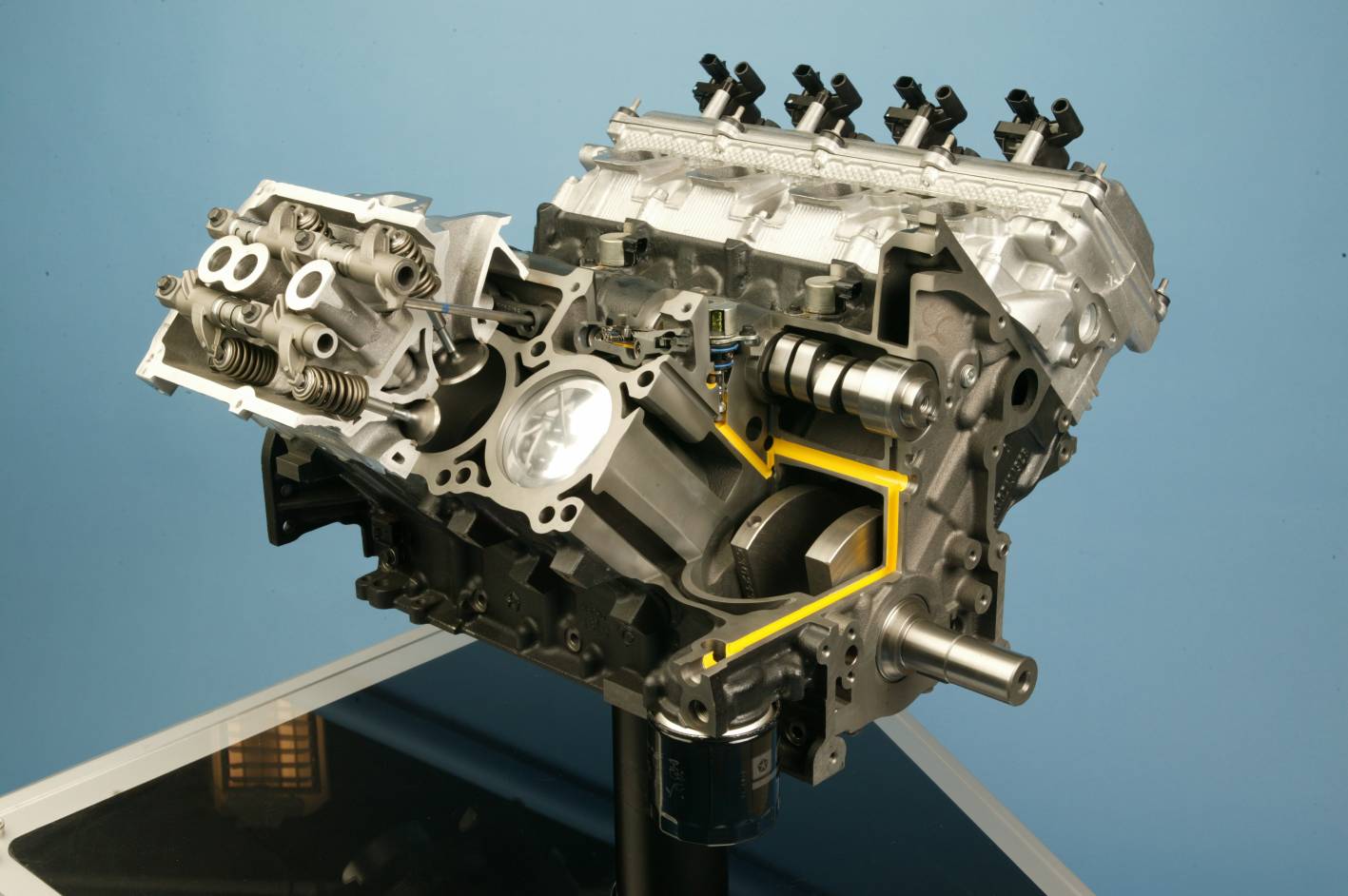Introduction
The Barra 220 was a 5.4-litre, 90-degree ‘V’ eight-cylinder petrol engine that was introduced in October 2002 in the Ford BA Falcon, Fairmont, Fairlane and LTD (see table below). A member of Ford’s Modular V8 engine family, the Barra V8 was produced at Ford’s Essex Plant in Windsor, Canada. Key features of the Barra V8 included its:
- Cast-iron block;
- Aluminium alloy cylinder head;
- Double overhead camshafts with variable intake and exhaust valve timing (Ford’s Variable Cam Timing or VCT);
- Four valves per cylinder;
- Maximum engine speed of 6000 rpm; and,
- Electronic ‘drive-by-wire’ throttle control.
Introduced in October 2005, the Barra 230 introduced dual knock sensors for more aggressive ignition calibration, ECU modifications and a larger diameter rear muffler (the Barra 220’s was shared with the Barra 182). Furthermore, the Barra 230 complied with Euro III emissions standards.
| Engine | Peak power | Peak torque | Model | Trans. | Years |
|---|---|---|---|---|---|
| 5.4-litre ‘Barra 220’ petrol V8 | 220kW at 4750rpm | 470Nm at 3250rpm | Ford BA Falcon | 5sp man., 4sp auto |
2002-05 |
| Ford BA Fairmont | 4sp auto | 2002-05 | |||
| Ford BA Fairlane Ghia/G220 | 4sp auto | 2002-05 | |||
| Ford BA LTD | 4sp auto | 2002-05 | |||
| 5.4-litre ‘Barra 230’ petrol V8 | 230kW at 5350rpm | 500Nm at 3500rpm | Ford BF Falcon, Ford BF Fairmont |
6sp auto | 2005-08 |
| Ford BF Fairlane Ghia/G8, Ford BF LTD |
6sp auto | 2005-07 |
Block
The Barra V8 engine had a cast iron block with 90.2 mm bores and a 105.8 mm stroke for a capacity of 5408 cc. The Barra V8 block was stiffer than the Windsor V8 it replaced, in part due to its computer-designed reinforcements that were cast into the block sidewalls and thicker metal along the gasket surfaces.
Unlike the related Boss 260 engine which had a forged steel crankshaft, the Barra V8 engine had a cast iron crankshaft. Compared to the Windsor V8, however, the pistons for the Barra V8 engine had longer side skirts to reduce piston slap.
Cylinder head
The Barra V8 engine had an aluminium cylinder head and a single overhead camshaft (SOHC) per cylinder bank; the camshafts were chain-driven individually and had a hydraulic chain tensioner on each timing chain. The camshafts actuated the three valves per cylinder – two intake and one exhaust – via roller finger followers, with ball tip hydraulic lash adjusters used to maintain zero valve clearance.
For each cylinder, the Barra V8 engine had two inlet valves with 34.00 mm diameters and a 37.5 mm diameter exhaust valve. Intake valve lift was 11.1 mm, while exhaust valve lift was 11.0 mm.
The Barra V8 engine had a magnesium cam cover that was isolated from vibration by rubber grommets. For rigidity, reinforcing ribs were cast into the cam cover and a structural baffle plate was fitted in the underside of the cover.
Variable Cam Timing
The Barra 220 engine had a vane-type VCT phaser – produced by Aisin – on each camshaft that provided continual variable adjustment within a 60 degree range (10 degrees advanced or 50 degrees retarded from the initial pin lock position). Each camshaft phaser was hydraulically controlled via an oil control valve that was mounted on top of it. However, the Barra 220 engine had Ford’s ‘Dual Equal Phase Shifting’ (DEPS) VCT system whereby the intake and exhaust camshafts could only be controlled synchronously. As such, intake and exhaust camshaft timing could only be advanced or retarded by the same degree simultaneously, and not independently.
At idle, the camshaft timing could be advanced by 10 degrees from the pin lock position for smoother running. On low throttle openings, however, the system could retard timing by as much as 50 degrees from the pin lock position to reduce fuel consumption and lower exhaust emissions via internal exhaust gas recirculation.
Intake
The Barra V8 engine had a dual resonance inlet manifold (also known as a variable length intake system). At low engine speeds, the intake runners would provide a longer path to increase the pulsing effect of the airflow and draw more air into the cylinder. At higher engine speeds, however, the length of the intake runners would be shortened to reduce intake resistance and allow a greater volume of air into the cylinder for top-end power.
The Barra V8 engine also had a closed-type Positive Crankcase Ventilation (PCV) system which recycled crankcase vapors to the upper intake manifold to reduce emissions.
Injection and ignition
The Barra V8 engine had sequential multiport fuel injection via eight solenoid-operated fuel injectors. A constant fuel pressure drop was maintained across the fuel injectors by the fuel pressure regulator which was positioned upstream from the fuel injectors on the fuel injection supply manifold. Furthermore, the Barra V8 engine had an electronic ignition system with eight ignition coils.
The Barra V8 engine had a compression ratio of 9.7:1 and firing order of 1-3-7-2-6-5-4-8.
Lubrication
The Barra V8 engine had a positive displacement internal gear oil pump with top seal rotors – commonly known as a gerotor pump – that was mounted on the front of the cylinder block. The Barra V8 engine required 10W30 GF2 engine oil.
Barra 230 changes
The Barra 230 V8 engine was introduced in Ford’s BF range, with the exception of the Ford BF Falcon Ute which continued with the Barra 220. Compared to the Barra 220, the Barra 230 V8 engine was fitted with two knock sensors for a more aggressive ignition calibration and a greater degree of spark advance. As a result, peak power and torque outputs increased to 230 kW at 5350 rpm and 500 Nm at 3500 rpm.





